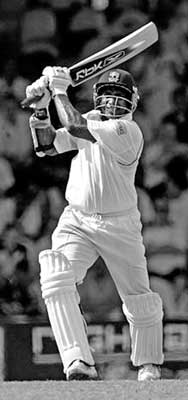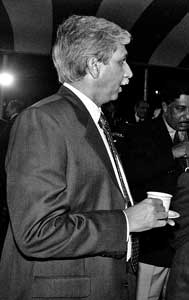Thank You Sanath,……..
 |
Sanath Jayasuriya decided to hang his gloves after a period of some fascinating pleasure that he gave to the Cricket lovers all over the world. I am not great at statistics, but possibly it was seventeen years of pure Cricketing genius and thus the pleasure for all that long. He has done it however on an occasion when Murali broke the world record, when Sangakarra won his team a test, and when Vaas played his 100th match.
All great occasions, but none as great as the passing way, metaphorically of course, of a genius. If that gives you an indication that other than being a diplomat and a great enthusiast for the sport, I somehow relish getting my turn with the bat, whenever there’s an opportunity, you are not too far from truth. But more importantly, I admit to being a passionate, a very passionate, follower and a lover of the game. In my days of school and club Cricket, coaches and manuals mostly explained the front-foot straight bat drive as the most fundamental Cricketing shot; always preferring the V, and more so because I took to open the innings because the ball still came pretty straight, and was hard, and my lean figure need not contrive shots; a poor over-pitched ball would generally offer one. Usually, the shots were few, since the bat was mostly kept and played straight. But I was adventurous too, and despite being aware of my limited genius with the bat, I would indulge in an odd square-cut: a shot that I simple love to this day. Any one who has ever held the bat and has not ever felt the greatest of worldly, or even heavenly pleasures, of a sweetly timed drive or a square-cut, has never known happiness.
Sanath did it all the time, and that is what left many of us awe struck. Being a left-hander, I can only feel his glee, when he saw one pitched slightly short with sufficient width on it, and a smart clack, and the ball was hitting the ropes. Most left- handers enjoy that and will do it for you for free, and as many times as you may like. And in fact most fall to the temptation as well; opposing skippers even buy their wickets by using the ploy. But man, you could not take the chance with Sanath. The Gulliies and the Cover always had to be packed, because he would contrive one, where no one thought one existed. In fact you had to somehow stop him from playing that shot, because speed was his strength and momentum his game-plan. When he got them going, the game or the moment was already lost to the opposing team. Would a more committed enthusiast ever sit down to determine who has been the fastest builder of his innings in the history of Cricket. I am certain Jayasuriya will be up there with the top ones.
 |
| Shahzad A Chaudhry |
I have known a few others too; I remember in a test against Australia, in Australia, as Majid Khan came into bat, I walked in to the bath room along with my transistor for my usual morning chores and to simply get ready for moving on with the day, and as I completed the usual routine, and was walking out, Majid was nearing his hundred. He was on fire, and that is when Lillee and he developed a personal battle of theirs. Majid went on to score his hundred soon after; I remember it was unique because it had rarely been done before lunch in a single session, and also for its intensity and since Majid was majestic, and spoke only with his bat. But then in the third test, Lillee promised to knock away Majid’s hat with the bouncer. Of course they didn’t use helmets then, and neither did we, but these were the then two gods of the game, meeting at the same level, and talking the language that only the two understood. While Majid was still majestic, Lillee was great too. And he bowled one that actually knocked Majid’s hat. For Majid, there was no ducking, just a stately presence, a shift of weight to execute the hook, but he missed. The ball being too good, and bowled by perhaps one of the greatest classical fast bowlers that history would have known. The hat fell away being neatly taken off by the ball; Lillee just followed through as fast bowlers do, in his momentum, picked up the hat and most respectfully handed it with a slight bow to Majid, as gentlemen are wont to do, Majid accepted it gracefully, put it on, settled it on his head, and was ready to face the next Lillee delivery. Even Stevens. No hassle, no fuss, just another afternoon at the park. Both exchanged their hats at the end of the day – a great souvenir from a gentleman’s game. Thank you Sanath for reminding us of this story. Without you, I wouldn’t have recollected this. Usually gentlemen remind of their ilk.
Sanath doesn’t know what he has given to the game; of course I assume, since he is only a practitioner, not an arm-chair connoisseur. The game of Cricket actually has been through a few revolutions as important as any other revolution in history, and I say this not out of passion but with a steadied seriousness. While W G Grace and his ilk may have given us the game, it was Bradman, who is seen as the biggest milestone in the history of the game. But that was then, and the game has moved on. There have been a few in the recent past that may not yet be revolutions per se, but seem to be some structural innovations meant to give a greater relevance to the games in the modern times; whether these are revolutions, only time will tell. But what Sanath brought to the game of Cricket has been a true and an established revolution. Cricket changed the day since Sanath played it his way. The effect has been universal. He brought in greater relevance to the game of modern Cricket. In fact he heralded modern Cricket. I hope humanity will understand that and remember that and record it as such. He will be and should be seen as the next major milestone in Cricket after Grace and Bradman.
Most left-handers do not bother much with their foot movement, somehow, and are mostly born with some god-gifted hand –eye coordination. This is so stark natural that any attempt to clad them with some studious and arduous coaching to a copy-book standard is actually taking the great pleasure out of their game. We need to stop judging them on those archival standards. You see, even the bowling has changed.
There isn’t the importance any longer of the great length delivery. Yes, Asif still bowls it, and to good effect with the new one, but essentially, these are the days of hitting the track hard; a slightly short of length, hitting the deck hard, bringing it up to the shoulder and letting the batsman do the rest. Bowlers don’t take wickets any longer, they make batsmen make mistakes. That takes away the need for any foot movement in the classical way. Sobers would be a sorry man today. What class and grace with those feet, but then they bowled differently then.
Now all Jayasuriya needed to do was to judge the length, and the height, cater to the swing or the movement if any, and voila. His attributes were just those, judging the length, the pace and the height earlier than any one else; the greatest hand-eye coordination in the history of the game; the force of his bat drawn from the strength of his forearms, and the results were most magnificent, most artistic, and most destructive softening of the leather. He earned the pleasure of those square cuts more than any other in the modern day history of cricket. Clean fine hitting became an art form. I know a purist might wince at that, but like I said, the game has changed, and we all need to accept that. Jayasuriya has been able to keep it fascinating despite the changes. And that is his credit. To illustrate my point, these days, Tests, yes Tests, could be lost for not playing fast enough in a couple of sessions; Mohammad Yousaf, still very much is a player that carries the conventional style, but I dare say he seems lost to me in the modern game, or must play out of his skin to play a more relevant game; ask Yunus, and probably he will also confirm a similar dilemma of style – he only manages the change a bit better. But Sanath never, never had this problem. He in fact is the architect of today’s game; the father if you like; and permit me to say the WG of the modern cricket. Yes Ponting and Clarke are two other exponents, and fine ones at that; but may I say the more refined, polished and coached species rather than the natural, endowed and gifted exponents of God,s selective wonders. Well I could be wrong, but the other lot will only continue to play on the game, albeit beautifully, as it exists. Never really change the game.
Thank you Sanath, for the pleasure.






















































No comments:
Post a Comment